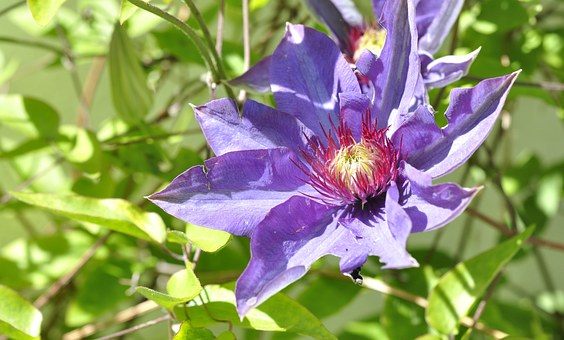Clematis ‘Jackmanti Superba’. This is the best-known and most popular of all hybrid clematis, and justly so. The eye-catching velvety dark purple, white-centered flowers are enormous — up to 6 inches across – and plentiful. If the plant is pruned almost to the ground in early spring it will climb to 10 to 12 ft by midsummer.
It is on this new growth that the flowers appear, most abundantly in July but continuing into October if there is the odd shower to bring the plant refreshment during relatively dry periods. Large-bloomed clematis such as this has a stately quality, and should not be allowed to scramble through trees and shrubs as their small-flowered cousins do.
‘Jackmanti Superba’ is a clematis for a pillar, pergola, or porch where air circulates freely; without this, the plant may suffer from mildew. If mildew does occur, spray the plant with benomyl solution. Clematis wilt is another problem, but one that occurs most often on well-trained plants; whole shoots wilt and die rapidly, though plants are rarely killed outright.
Wilted shoots should be cut out. Healthy new stems to replace them usually develop from ground level. Like other hybrids, ‘Jackmanti Superba’ is deciduous. Clematis and roses make a partnership as mutually flattering as buttercups and daisies, and the deep hue of this clematis harmonizes equally well with pink, creamy-white, or yellow roses.
You might, for example, train it up a dark brown trellis on one side of a stone porch, with the climbing rose ‘The New Dawn’ growing up the other side, so that the two meet and intertwine in a riot of color at the top. The soft, silvery-pink, double flowers of the rose bloom, like the clematis, throughout the summer, and add their sweet fragrance to what is a particularly charming association.
At its foot you could include a clump of the pink-flowered rock rose “Helianthemum nummularium” ‘Wisley Bridesmaid’, only 4 to 6 inches high but with a spread of around 2 ft. This beautiful flower profusely in June and July and above a mass of gray foliage, and it is very useful for shading the roots of the clematis. I
n 1858, a nurseryman George Jackman crossed the clematis lanuginose, clematic viticella, and climatic x hendersonii and then introduced them in 1862. Thus, the violet-purple flowering vine is named after the nurserymen.







